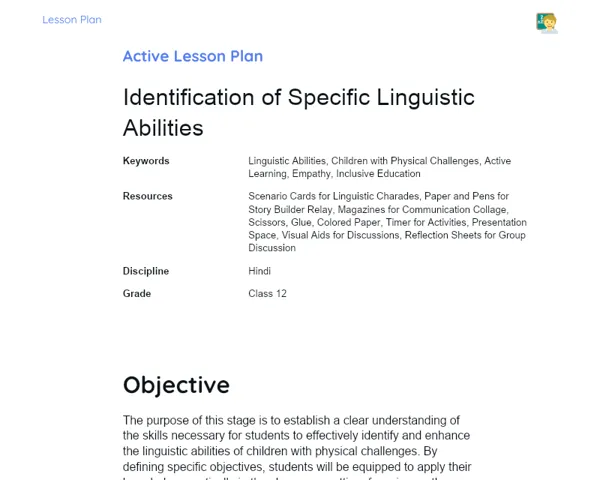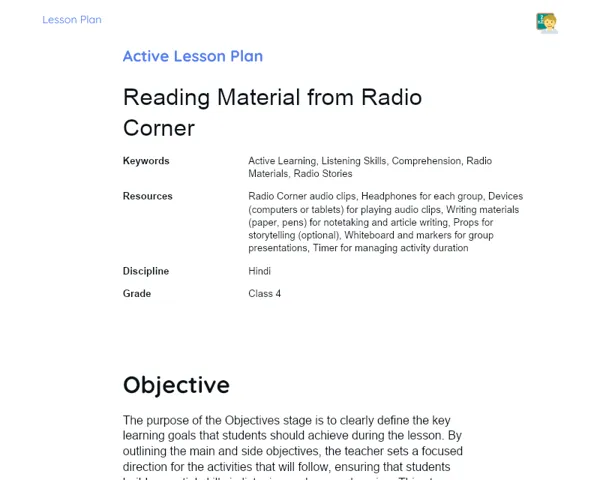Lesson Plan | Socioemotional Learning | Subtle Comparison of Shapes
| Keywords | Subtle Comparison of Shapes, Emotional Intelligence, RULER Method, Shape Recognition, Self-Awareness, Social Skills, Cognitive Development, Emotion Labeling, Team Activities, Real-Life Connections |
| Resources | Picture cards of different shapes (circles, squares, triangles, rectangles), Emotion vocabulary chart, Drawing paper, Crayons or colored pencils, Whiteboard and markers, A quiet space for mindful exploration, Comfortable seating arrangements (chairs or floor cushions), A timer for activity intervals, A reflection journal for each student |
| Codes | - |
| Grade | Class 1 |
| Discipline | Hindi |
Objectives
Duration: 10 - 15 minutes
The purpose of this step is to lay the groundwork for the lesson by clearly outlining the objectives that will guide the learning experience. By establishing these goals, students will understand what they are expected to learn and achieve during the lesson. This fosters a sense of direction and motivation, encouraging them to engage not only with the shapes but also with their own feelings and thoughts as they explore the similarities and differences in the shapes presented. The focus on emotional intelligence will enable them to build connections with their peers and the subject matter, creating a supportive learning environment where everyone feels valued and motivated to participate.
Main Objectives
1. To help students recognize and differentiate between various shapes through subtle comparisons.
2. To enhance students' emotional vocabulary by labeling emotions associated with shapes and their characteristics.
Introduction
Duration: 10 - 15 minutes
Emotional Warmup Activity
Shape-Focused Attention
Mindful Shape Exploration
1. Gather the students in a quiet space where they can sit comfortably, either on chairs or on the floor.
2. Invite them to close their eyes or soften their gaze to minimize distractions.
3. Guide them to take deep breaths, inhaling through their noses and exhaling slowly through their mouths, encouraging them to feel their chests rise and fall.
4. Prompt them to think about their favorite shapes—like circles, triangles, or squares—and visualize those shapes in their minds.
5. Ask them to imagine what those shapes might feel like if they were to touch them. For example, is a circle smooth or does a square have sharp edges?
6. Encourage them to focus fully on the shapes they visualize, identifying any emotions that arise in them as they think about each shape.
7. After 5-7 minutes, gently ask the students to open their eyes and discuss how they felt during the exploration.
Content Contextualization
Understanding shapes is not just a mathematical exercise; it's about connecting with the world around us. Take, for instance, the football we play with in the playground, which is a sphere, or the squares and rectangles found in the walls of our classrooms. When students look at shapes, they are not just observing but also recognizing how these shapes are present in their daily lives. By learning to make subtle comparisons between shapes, students will not only develop their cognitive skills in identifying shapes but will also learn to appreciate the variety and beauty in the diversity of the world around us. This process fosters their emotional intelligence as they relate their feelings to shapes, creating a rich learning experience that integrates both intellect and emotion.
Development
Duration: 60 - 75 minutes
Theory Guide
Duration: 20 - 30 minutes
1. Introduce basic shapes: Explain that shapes are everywhere, from the books we read to the buildings we see. Define shapes like circles, squares, triangles, and rectangles, emphasizing their characteristics.
2. Discuss similarities and differences: Highlight how different shapes can be similar in some features (like sides or angles) but differ in others (like symmetry or size). Use real-life examples such as a round plate (circle) versus a square table (square).
3. Introduce subtle comparison: Explain that subtle comparison means looking closely at the similarities and differences among shapes. This helps us understand the world better. Use visual aids, such as a picture showing various shapes side by side, and guide students to identify what makes them unique.
4. Emphasize emotional connection: Discuss how shapes can evoke feelings. For instance, a circle may feel safe and comforting, while a triangle might feel sharp and dynamic. Ask the students to share their feelings about shapes.
Activity with Socioemotional Feedback
Duration: 15 - 20 minutes
Shape Comparison Relay
In this engaging relay activity, students will work in teams to compare shapes displayed in pictures. Each group will be assigned different shapes to analyze, encouraging them to use both cognitive and emotional intelligence in their discussions. Students will discuss the physical attributes of their assigned shapes and share their feelings about them. They will need to make subtle comparisons, identifying both similarities and differences before presenting their findings to the class.
1. Divide the class into small groups of 4-5 students.
2. Provide each group with a set of different shape pictures, including circles, squares, triangles, and rectangles.
3. Instruct each group to discuss their assigned shapes, focusing on identifying characteristics, similarities, and differences, and how those shapes make them feel.
4. Allow the students 15 minutes to prepare their observations and emotional connections regarding the shapes.
5. Ask each group to present their conclusions to the class, sharing both their comparative analysis and emotional experiences related to the shapes.
Discussion and Group Feedback
After each group has presented, lead a guided discussion using RULER to deepen students' understanding of emotions related to shapes. Begin with 'Recognize' by asking students to identify any emotions they felt while discussing their shapes or listening to other groups. Then transition to 'Understand' by exploring the reasons behind those feelings, prompting students to think about what aspects of the shapes triggered specific emotions.
Next, use the 'Label' aspect by encouraging students to describe their emotions using a feeling vocabulary chart. Guide the discussion to ensure they accurately label the emotions. Moving on to 'Express,' invite students to share their feelings openly with their peers, reinforcing a supportive environment. Finally, address the 'Regulate' component by discussing how students can adjust their views or feelings towards shapes or other subjects, promoting emotional resilience and adaptability.
Conclusion
Duration: 15 - 20 minutes
Reflection and Emotional Regulation
To conduct a reflection on the lesson, the teacher can organize a circle time discussion where each student shares one challenge they faced during the activities and how they felt they managed their emotions during those moments. The teacher should encourage students to express both their positive and negative feelings, promoting a safe space for emotional sharing. Alternatively, a written reflection can be assigned where students draw or write about their experiences, focusing on a specific shape they connected with emotionally and how recognizing their feelings helped them enjoy the exploration more.
Objective: The objective of this subsection is to encourage self-assessment and promote emotional regulation. By reflecting on their experiences and emotional responses during the lesson, students will learn to identify effective strategies to manage their feelings in challenging situations. This practice will help cultivate resilience and improve their ability to navigate their emotions in future learning contexts.
Glimpse into the Future
The teacher can guide a discussion on setting personal and academic goals that stem from the concepts learnt. Each student can be prompted to think about how they can incorporate the understanding of shapes into their daily lives, perhaps by identifying shapes around their homes or setting a goal to learn about a new shape each week. This discussion should also tie in how students can express their emotions related to shapes, thereby encouraging consistent emotional exploration.
Setting Goals:
1. Identify at least three different shapes in the classroom during the week.
2. Express feelings associated with shapes through drawing or speaking.
3. Share one thing learned about shapes and emotions with a family member. Objective: The objective of this subsection is to strengthen students' autonomy and harness the practical application of their learning. By setting personal and academic goals, students will take ownership of their exploration of shapes and their associated feelings, aiming for continuity in both academic success and personal development as they learn to incorporate emotional intelligence into their everyday activities.



